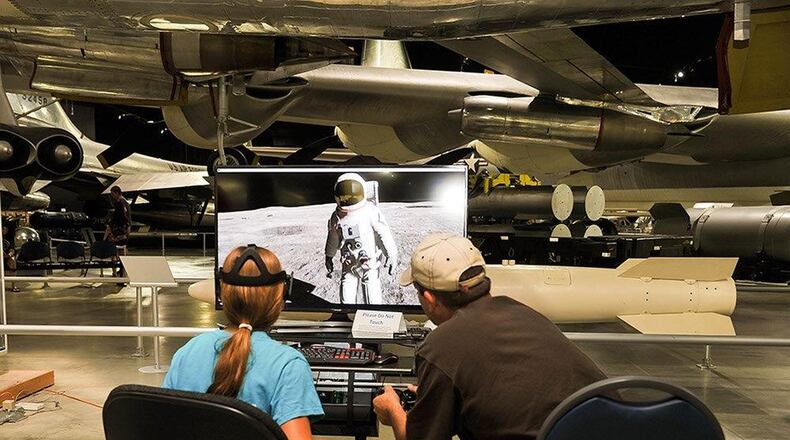A popular attraction was the Oculus Rift, a hands-on exhibit and virtual reality computer simulation where the user could experience what it would be like to walk on the moon.
“We use Oculus Rift and other technologies to enhance the learning experience,” said Pat Hannon, museum education specialist. “Studies have shown that students and visitors will remember and better understand a subject if they have the opportunity to experience the subject.”
The Oculus Rift consists of a piece of head gear that looks much like a pair of ski goggles. Earphones are attached to the head gear, enabling the user to hear conversations between the astronauts and NASA’s mission control room. Unlike gaming controllers or joysticks, there are two separate controllers that are a little smaller than the palm of a hand to give the user the ability to move about.
Users were able to “walk” next to the lunar module, the American flag and bounce around the surface with astronauts Neil Armstrong or Buzz Aldrin. Looking up, planet Earth was visible as well as the sun.
President Richard Nixon can be heard through the headphones congratulating the astronauts for their success. There was no chance of falling off the moon surface though, as a blue fence appears when one was getting too close to the “edge.”
“Our hope is that this simple experience will inspire our visitors to pursue a career in space exploration or one of its related fields,” Hannon said.
Another popular activity was model rocket building. Children were given a free model rocket kit; instructors were present to help with the assembly and to answer any questions.
Wright Stuff Rocketeers 703, a local rocketry club, was on hand to assist with launching rockets from the museum field.
“We place a strong emphasis on outreach activities, not only to get youth involved in the hobby, but also to let educators and programmers know that if they want to include rocketry in their curriculum, there is a group nearby that is ready with the personnel, equipment and expertise to run that portion of the program, allowing them to focus on teaching the material,” said Dave Combs, club president. “We know that early, positive experiences with rocketry can yield specific and long-lasting results.
“Today’s first flight at the museum often becomes tomorrow’s school or fair project, which leads to a career in the sciences,” he said.
About the Author
